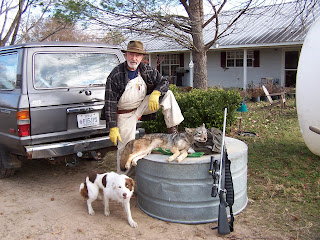Its cold outside as the earth breathes in winter air, drawing fresh nourishment from the stars for another year of growth, invigorating the roots and underworld organisms; short daylight hours provide much needed rest for all living things. At this restful time of year we animal husbandry men must be more vigilant to the increased needs and opportunities for the creatures of the night.
More night time affords more hours to roam and find domestic prey that is resting this time of year. Some of the vermin and varmints we deal with here in East Texas are: wild hog, feral, dropped-off house cats, wild dog, raccoon, opossum, skunk, rat, bob cat, owl, and the most organized of them all - the coyote.
Our population of these vermin seems to be on the rise and demands on this farmer now require me to be on watch several nights per week to protect the cattle, goats, chickens, and of course our barn cat – “Col. Gustav Hoffman”. One of our previous interns constructed a concealed shooting blind over/above the chicken roost room and I can lay down up there and wait for the raccoon (or other) to enter the barn and make his kill. There is room enough for in my ‘blind’ me to enjoy a glass of wine with cheese as well as smoke a cigar while I await the nocturnal visitor(.s)
I have killed numerous coons, skunks and opossums from that little perch. I find Nancy’s dad’s old single shot .410 shotgun with #4 shells very effective on these would-be chicken killers. Seems my killing of them doesn’t communicate to their family; as, more of them always arrive in a short time and will till the weather warms up and other sources of prey become plentiful again in the wild.
Depicted in the photo above is a coyote that I dispatched 14 DEC 10. She (the coyote) is well fed and very beautiful. She was one of three attempting to stress our ducks (on the pond) to shore for a kill about 04:00. That same night in the adjacent paddock a calf was delivered, and there very likely would have been trouble if the coyote had not been pre-occupied warting (aggravating) those ducks.
This time of year we have a few calves being born and these coyotes get excited by the whiffs of afterbirth on the winter wind. So each morning I walk the pastures and look for a new birth – hopefully before the buzzards find it. But most times the calf is born in a draw or clump of bushes or trees as the mama wants to protect it from the creatures we are discussing. What I am blessed to see is the little bugger darting out to play on its new found legs and enjoying the first hours of new life.
I’m asked about predator incursions into our herds and flock: this has been a bad year for that. We have a mountain lion that makes this place a part of his/her 5 year circle, and it killed a $5,000 bred heifer and later carried off 2 goats without a trace – it’s a big one.
How to deal with each of the predators is based on being able to recognize the death scene signs to determine the course of action that will lead to termination of future deaths of our stock.
Each creature has a favorite way to kill and a way to handle what it’s killed. I know these things from the presence of my dad and grandpa in my life. As a child I watched how they garnered facts from the death scene of an animal and drew a conclusion from those facts. Based on their prognosis they would and I still do develop an action plan to return vengeance on that particular varmint and return security to the farm animals.
---- Next time I get a chance I'll discuss
Each Varmint Has A Killing Method:







